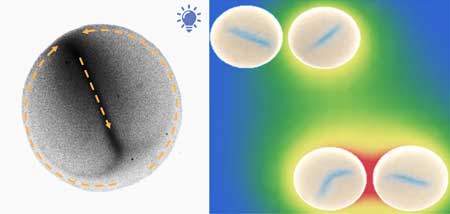| May 05, 2020 | |
Drops of nanoparticles self-stir and communicate(Nanowerk News) Researchers at the Max Planck Institute for Intelligent Systems have discovered a new mechanism of self-organization of active matter. When photochemically active nanoparticles are enclosed at high density within a drop and are exposed to UV light, a self-organized flow pattern emerges by spontaneous symmetry breaking. |
|
| Furthermore, each drop communicates with neighbouring drops by exchanging chemicals, and coordination of their internal flows occurs – even when far apart. | |
| Communication and organized behaviour is considered to be the quintessence of living systems. For example, understanding how cellular patterns form is one of the most interesting phenomena of biological systems. | |
| Insights into nature’s ability to actively self-organize can be harnessed by science in many ways, potentially leading to the design of a new class of interactive materials. Scientists from the Micro, Nano and Molecular Systems Lab at the Max Planck Institute for Intelligent Systems (MPI-IS) in Stuttgart have now succeeded in bringing drops of nanoparticles to exhibit internal self-organization and to communicate. | |
| Their work was published in Nature Communications ("Interface-mediated spontaneous symmetry breaking and mutual communication between drops containing chemically active particles"). | |
 |
|
| Single drop with active nanoparticles that collectively organize (left); and several drops that communicate to coordinate their flow patterns (right). (Image": MPIS) | |
| The researchers from the MPI-IS teamed up with scientists from the University of Seville in Spain. Together they found a simple yet highly interactive form of artificial active matter. They used powders of titanium dioxide (TiO2) and added them together with peroxide to a water droplet. | |
| “The particles start to catalyse chemical reactions when they are illuminated with UV light. Although the individual particles are not motile, things are very different when many of them come together. By enclosing a large number of nanoparticles in a drop, we were able to get a very dense system of active particles and observe them”, explains Dhruv Singh, the first author of the study. | |
| Until recently, he was a Postdoctoral Fellow at the MPI-IS and is now an Assistant Professor at the Indian Institute of Technology Bhilai in India. | |
| “The droplet containing the TiO2 particles was carefully placed inside oil. Upon illumination we saw how flows developed spontaneously within the drop and the TiO2 particles self-organized into a well-defined pattern,” Singh adds. | |
| The researchers see this phenomenology emerging through a novel mechanism involving the interplay between the geometrical confinement provided by the drop and the flow-driving compositional changes at the surface of the drop (Marangoni stresses) that are created by the chemical reactions occurring among the particles. | |
| Remarkably, these active drops not only show collective organization inside each drop, but they also interact with neighbouring drops and “coordinate” their respective internal flows, even when they are far apart. | |
| “Our study illustrates how simple active particles, if present in large numbers and at high density, can give rise to macroscopically ordered systems and chemical communication” says Peer Fischer who heads the Micro, Nano and Molecular Systems Lab at the MPI-IS and who is a Professor of Physical Chemistry at the University of Stuttgart. “We have realized highly dense active systems and found a model system to study collective phenomena. The drops can be used to organize flows and pump solutions”, Singh concludes. |
| Source: Max Planck Institute for Intelligent Systems | |
|
Subscribe to a free copy of one of our daily Nanowerk Newsletter Email Digests with a compilation of all of the day's news. |
